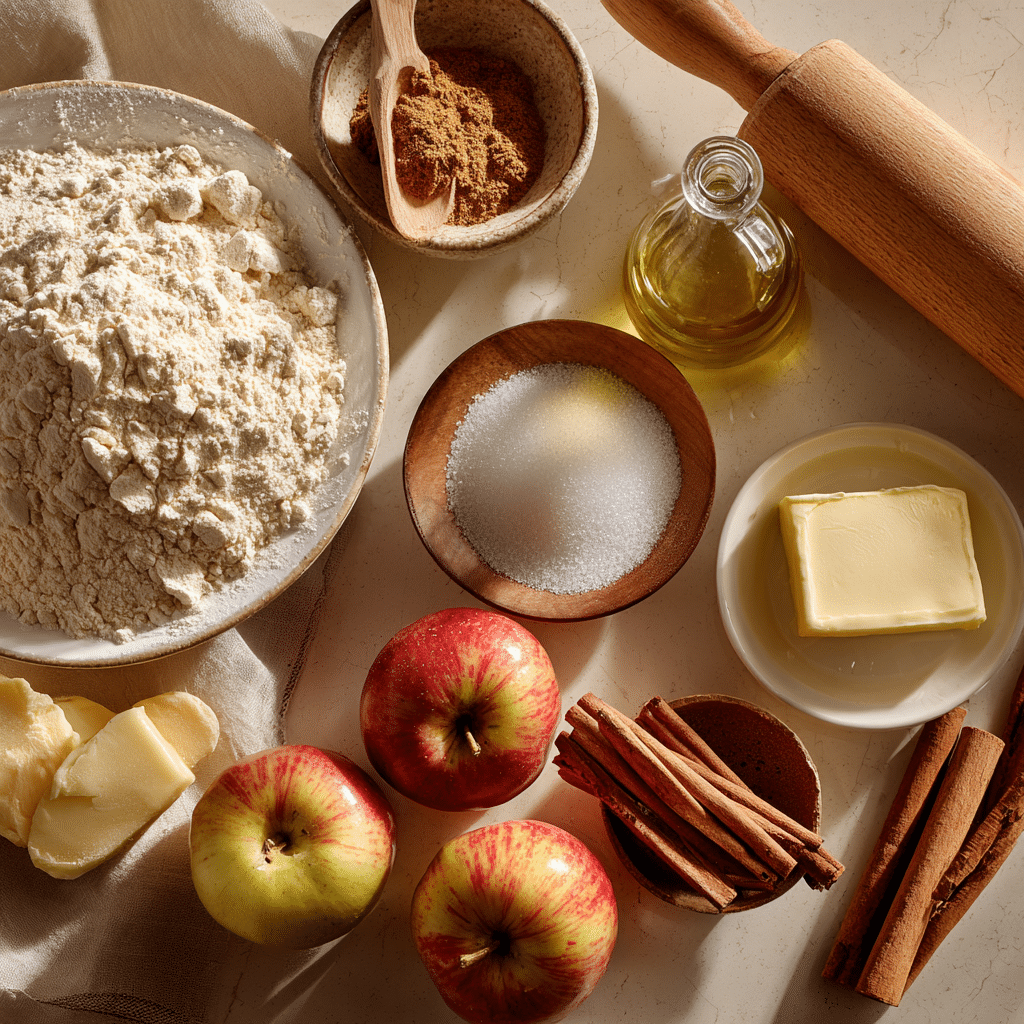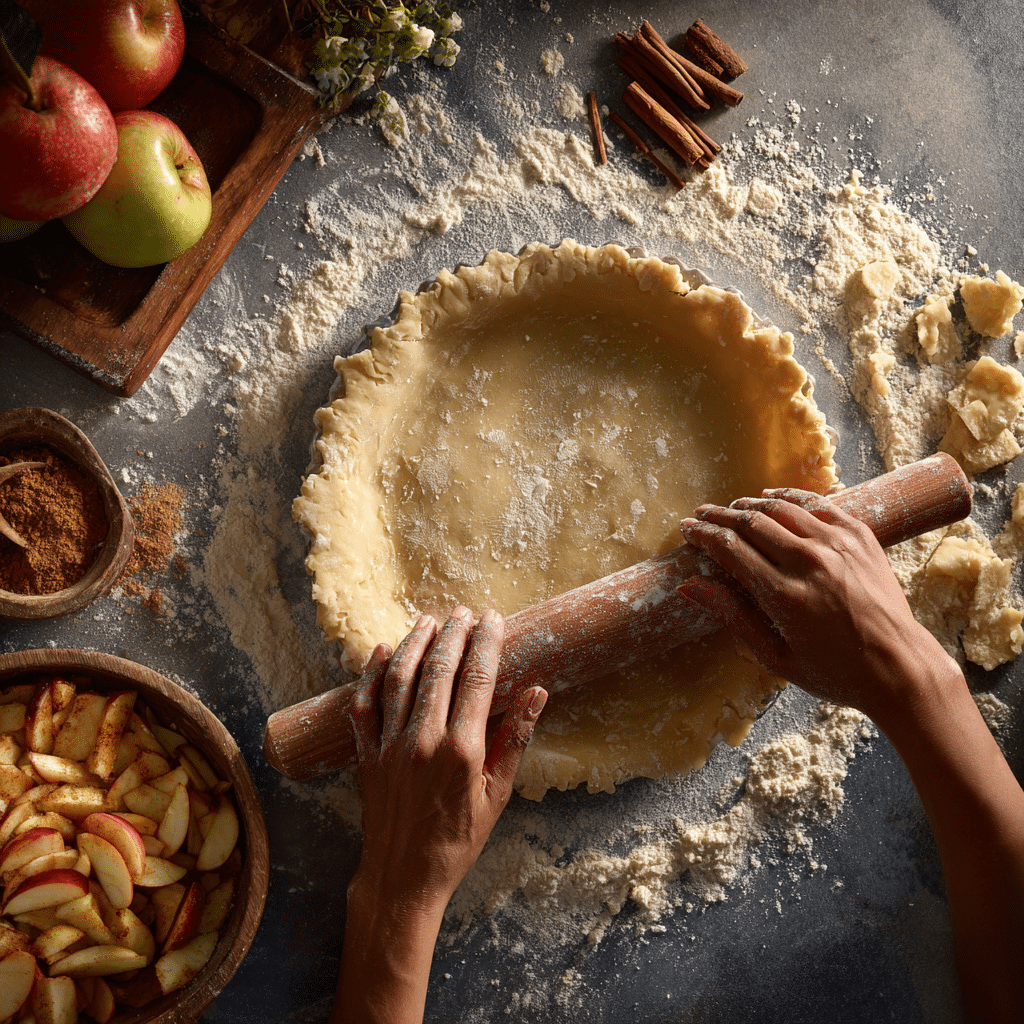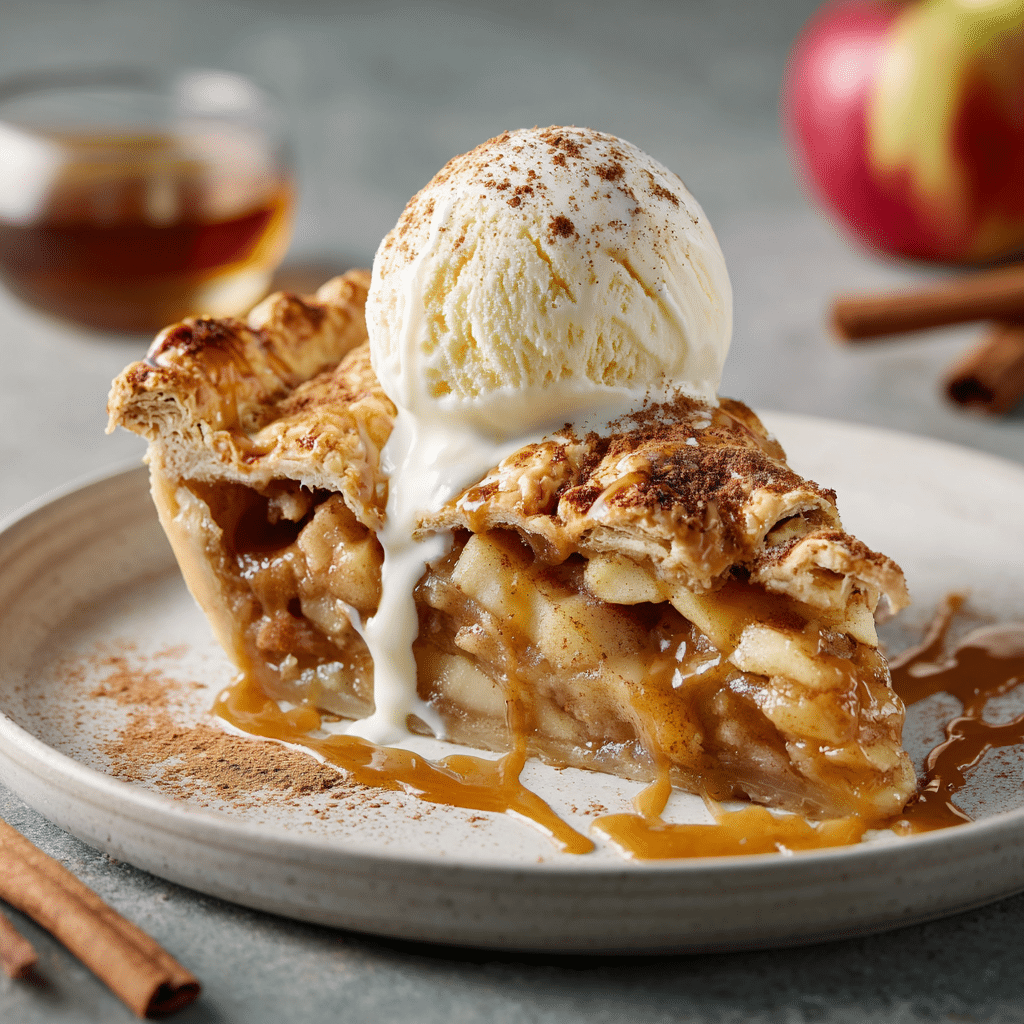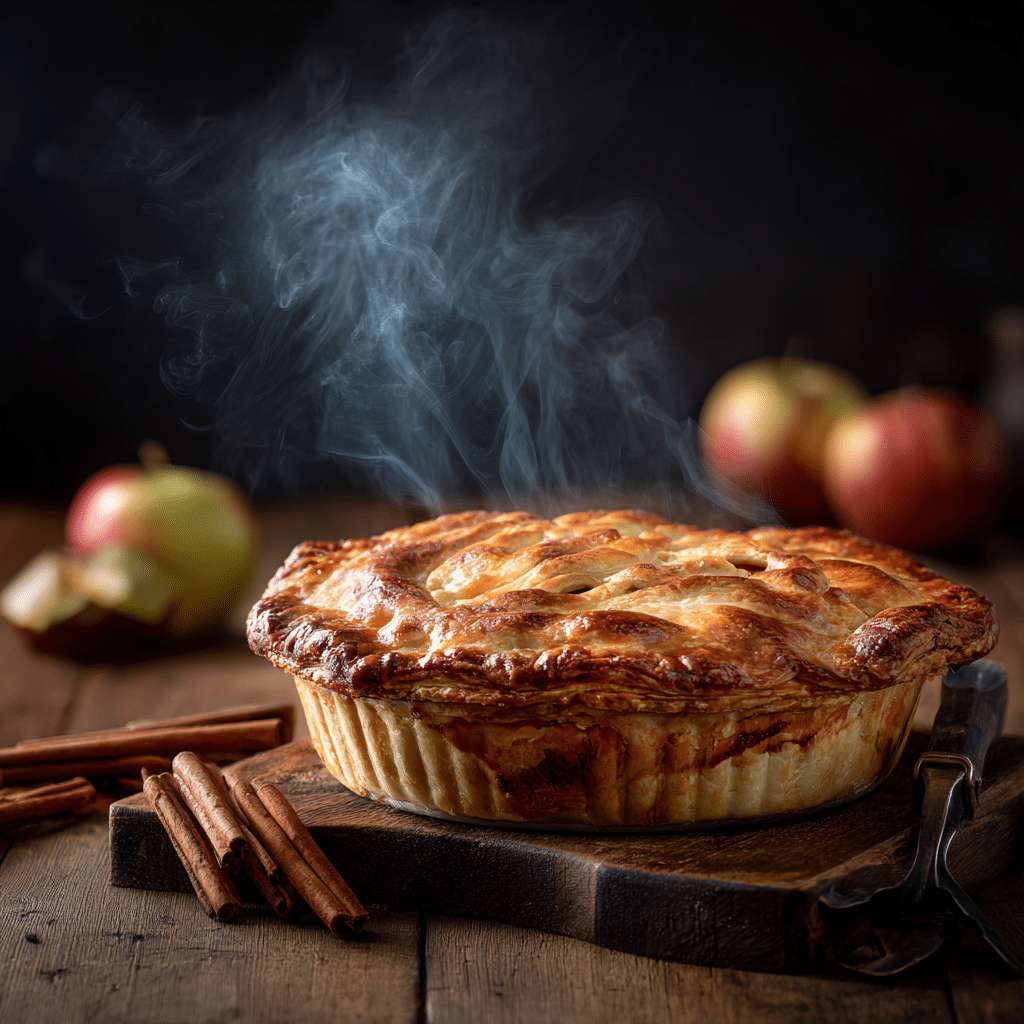Few desserts capture the heart of comfort food quite like the apple pie recipe. With its golden flaky crust, warm spiced apple filling, and irresistible aroma, this classic dessert has earned a permanent spot at family gatherings, holidays, and weekend dinners. Whether served on its own, paired with ice cream, or dressed up with whipped cream, apple pie is a treat that never goes out of style.
The magic of a good apple pie lies in the balance tender apples cooked just right, a crust that’s crisp yet buttery, and the perfect amount of spice to bring out the natural sweetness of the fruit. While it may seem simple, baking the perfect apple pie requires a mix of technique, patience, and a few insider secrets.
In this guide, we’ll explore the history of apple pie, break down its essential ingredients, walk through a step-by-step baking method, and share professional tips to avoid common mistakes. By the end, you’ll not only know how to bake a pie that rivals bakery quality but also understand why apple pie is often called the ultimate American dessert. If you love classic baked goods, don’t miss our other homemade dessert recipes that bring the same comfort and charm to your table.
Why Apple Pie is America’s Favorite Dessert
Apple pie has been celebrated in the United States for centuries, often called a symbol of tradition and home. The phrase “as American as apple pie” reflects how deeply this dessert is woven into the culture. Unlike more complex pastries, apple pie feels approachable anyone with a few basic ingredients can bake one. Its popularity skyrockets during fall, especially around Thanksgiving, but it’s equally loved year-round.
Beyond tradition, apple pie holds emotional value. It’s tied to family gatherings, childhood memories, and celebrations. A single slice often brings comfort and nostalgia, which explains why so many people return to this dessert again and again.
The Timeless Charm of Homemade Apple Pie
While store-bought pies are convenient, nothing compares to a freshly baked homemade apple pie. The smell of cinnamon and baked apples filling the kitchen is an experience in itself. Baking at home also gives you the freedom to control sweetness, experiment with crusts, and use the freshest apples available.
The apple pie recipe endures because it’s both versatile and forgiving. You can make it rustic or refined, traditional or modern, double-crusted or open-faced. No matter the variation, the end result is always satisfying a dessert that’s loved across generations.
History and Origins of Apple Pie
European Roots of Apple Pie
The story of the apple pie recipe begins long before it became an American favorite. The earliest documented apple pies appeared in England during the 14th century, where they were made with apples, figs, raisins, pears, and saffron. Unlike today’s sweet and buttery crusts, those pies often had savory-style pastry shells, sometimes called coffins, which acted more as containers than edible parts of the dish.
From England, the recipe spread across Europe. The Dutch became famous for their spiced apple pies topped with lattices or crumb toppings, while the French created elegant tarts that highlighted the fruit’s natural sweetness. Over time, cinnamon, nutmeg, and sugar became standard flavorings, elevating apple pie from a rustic dish to a celebrated dessert.
How Apple Pie Became an American Icon
When European settlers brought their pie traditions to North America, they found an abundance of apple orchards making the fruit an ideal filling. By the 18th and 19th centuries, apple pie had already become a staple in American homes. Its affordability, simplicity, and ability to feed large families helped solidify its place in everyday cooking.
In the 20th century, apple pie transformed into more than just food it became a cultural symbol of America. The phrase “as American as apple pie” emerged during World War II, when soldiers claimed they were fighting for “mom and apple pie,” reinforcing its association with home, family, and national pride.
Today, apple pie remains a centerpiece of American holidays like Thanksgiving and the Fourth of July, while also being enjoyed in countless variations around the world. Its enduring legacy shows how a simple recipe can become a timeless cultural icon.
Essential Ingredients for Apple Pie Recipe

Core Ingredients Every Apple Pie Needs
The beauty of the apple pie recipe lies in its simplicity. With just a handful of ingredients, you can create a dessert that feels rich, comforting, and satisfying. Here are the essentials:
- Pie Crust – Either homemade or store-bought, the crust is the foundation. A good crust should be flaky, buttery, and strong enough to hold the filling.
- Apples – The star of the pie. Choosing the right variety makes all the difference in flavor and texture.
- Sugar – Typically granulated or brown sugar to sweeten the apples and balance tartness.
- Spices – Cinnamon is the classic choice, often paired with nutmeg, allspice, or cloves for depth.
- Thickener – Flour, cornstarch, or tapioca helps thicken the apple filling as it bakes.
- Lemon Juice – A splash of acidity prevents the apples from browning and brightens the flavor.
- Butter – Small cubes of butter added before baking enrich the filling and enhance flavor.
These basics form the backbone of a traditional apple pie. While you can add creative twists, sticking to these essentials ensures a delicious, well-structured dessert.
Choosing the Best Apples for Apple Pie
Not all apples are created equal when it comes to pie. The key is to pick varieties that hold their shape when baked and provide the right balance of sweet and tart flavors.
Best apples for apple pie:
- Granny Smith – Tart, firm, and reliable for baking.
- Honeycrisp – Sweet-tart with a crisp texture.
- Braeburn – Spicy-sweet and holds up well in heat.
- Jonagold – A mix of sweetness and tanginess.
- Golden Delicious – Mild and sweet, good for mixing with tarter apples.
Pro tip: Using a blend of apple varieties creates a more complex flavor. For example, pairing Granny Smith (tart) with Honeycrisp (sweet) gives the pie both brightness and richness.
| Apple Variety | Flavor Profile | Best Use in Pie |
|---|---|---|
| Granny Smith | Tart, firm | Classic choice, balances sweetness |
| Honeycrisp | Sweet-tart | Juicy, adds brightness |
| Braeburn | Spicy-sweet | Adds complexity |
| Jonagold | Sweet-tangy | Enhances depth of flavor |
| Golden Delicious | Mildly sweet | Balances tart apples |
Choosing the right apples is the first step in ensuring your apple pie recipe turns out flavorful and perfectly textured.
Step-by-Step Guide to Making Apple Pie

Preparing the Crust (Homemade vs Store-Bought)
A great apple pie recipe begins with the crust. While store-bought options are convenient, nothing compares to the flavor and flakiness of a homemade pie crust. Here’s how you can approach both:
Homemade Pie Crust:
- Combine flour, salt, and cold butter cubes.
- Cut the butter into the flour until the mixture resembles coarse crumbs.
- Add ice water a tablespoon at a time until the dough comes together.
- Divide the dough into two discs, wrap in plastic, and chill for at least 1 hour.
Store-Bought Pie Crust:
- If short on time, use pre-made crusts.
- Choose a high-quality, butter-based option for better flavor.
- Allow the crust to come to room temperature before rolling to avoid cracks.
No matter which you choose, the key is keeping ingredients cold to ensure a flaky, tender crust.
Cooking and Assembling the Filling
The filling is the heart of the apple pie recipe. Preparing it properly ensures the apples cook evenly and the pie sets beautifully.
Ingredients for Filling:
- 6–7 cups of sliced apples (Granny Smith, Honeycrisp, or a mix)
- ¾ cup granulated sugar (or half white, half brown sugar)
- 2 tablespoons flour or cornstarch
- 1 teaspoon cinnamon
- ¼ teaspoon nutmeg
- 1 tablespoon lemon juice
- 2 tablespoons butter
Steps:
- Peel, core, and slice the apples into even wedges.
- Toss apples in a bowl with sugar, spices, flour, and lemon juice. Let sit for 10 minutes to release juices.
- Roll out one crust and place it into a 9-inch pie dish. Trim excess dough at the edges.
- Pour the apple filling into the crust, spreading evenly. Dot with butter cubes.
- Cover with the second crust (or lattice style) and seal the edges. Cut small slits in the top for steam to escape.
- Brush the top with an egg wash (1 beaten egg + 1 tbsp water) for a golden finish.
- Bake at 375°F (190°C) for 50–60 minutes, until the crust is golden and the filling bubbles.
- Cool for at least 2 hours before slicing to allow the filling to set.
| Step | Process | Key Tip |
|---|---|---|
| 1 | Prepare crust | Keep butter cold |
| 2 | Mix filling | Let apples release juices |
| 3 | Assemble pie | Seal edges well |
| 4 | Bake | Watch for bubbling filling |
| 5 | Cool | Prevents runny slices |
With these steps, your apple pie recipe will turn out crisp on the outside, gooey and spiced on the inside—just like a bakery-quality pie.Tips and Secrets for the Perfect Apple Pie
What Makes Apple Pie Filling Flavorful
The soul of the apple pie recipe lies in its filling, and getting it right requires more than just tossing apples with sugar and spice. Here are some secrets to elevate your filling:
- Mix apple varieties – Combining tart and sweet apples gives the filling complexity. Granny Smith brings acidity, while Honeycrisp or Golden Delicious add natural sweetness.
- Pre-cook some apples – Lightly sautéing half of the apple slices softens them while leaving the rest fresh ensures a mix of textures.
- Balance sweetness and spice – Too much sugar can overwhelm the apples, while too little spice leaves the pie bland. A mix of cinnamon, nutmeg, and a pinch of allspice often does the trick.
- Add a thickener – Using cornstarch or flour helps absorb juices released during baking, preventing a runny pie.
- Touch of citrus – A little lemon zest or juice brightens the filling and prevents it from becoming too heavy.
These small adjustments ensure that each bite delivers a perfect balance of sweet, tart, and spiced flavors.
Techniques for Flaky, Golden Pie Crust
The crust can make or break your apple pie recipe. A soggy bottom or tough edges can ruin an otherwise perfect filling. Here are techniques bakers swear by:
- Use cold ingredients – Keep butter, water, and even flour chilled until ready to use. This prevents the fat from melting too early.
- Don’t overwork the dough – Handle the crust as little as possible to avoid developing excess gluten, which can make it tough.
- Chill before baking – Once assembled, refrigerate the pie for 15–20 minutes before baking. This helps the crust firm up and hold its shape.
- Egg wash for shine – Brushing with egg wash gives the crust a glossy, golden finish. For extra sweetness, sprinkle with coarse sugar.
- Bake on a lower rack – Positioning the pie closer to the heat ensures the bottom crust cooks through and doesn’t stay soggy.
- Use a pie shield – Covering the edges with foil halfway through baking prevents them from burning before the center is done.
| Secret | Why It Works | Result |
|---|---|---|
| Cold butter | Creates steam pockets | Flaky layers |
| Citrus in filling | Balances flavor | Bright, fresh taste |
| Chilling assembled pie | Firms up crust | Prevents shrinkage |
| Egg wash + sugar | Enhances crust | Golden, glossy look |
With these tips, your apple pie recipe will have the irresistible combination of a flaky, buttery crust and a rich, spiced apple filling that keeps everyone coming back for seconds.
Common Mistakes and How to Avoid Them
Overbaking and Underbaking Issues
One of the most common mistakes when making an apple pie recipe is baking it for the wrong amount of time.
- Underbaked pies often have soggy bottoms and firm apples that haven’t softened enough. This usually happens when bakers pull the pie out too early, worried about burning the crust.
- Overbaked pies can have dried-out filling, burnt crust edges, and a chewy texture that ruins the experience.
Solution: Bake the pie until the filling is visibly bubbling through the crust vents or lattice. This ensures the thickener has activated and the apples are fully cooked. Use a pie shield or foil to protect the edges if they brown too quickly.
Mistakes in Filling Consistency
Another major issue is ending up with a filling that’s either too runny or too dry. Both problems can be avoided with the right techniques.
- Runny filling happens when apples release too much liquid, and not enough thickener is used.
- Dry filling results from using too little sugar or over-thickening with flour or cornstarch.
Solution: Toss apples with sugar and spices, then let them sit for about 10 minutes before adding them to the crust. This draws out excess juices that can be drained or thickened before baking. Also, use the right ratio of thickener—about 2 tablespoons of cornstarch or 3 tablespoons of flour for every 6–7 cups of apples.
Bonus Tips to Avoid Other Pitfalls:
- Don’t skip the cooling step: Cutting into a hot pie too soon causes the filling to run out. Always let it rest for at least 2 hours.
- Avoid overstuffing: Piling too many apples can cause overflow and uneven baking. Stick to about 6–7 cups of sliced apples.
- Mind your spice balance: Too much cinnamon can overpower the apples, while too little leaves the pie bland.
| Mistake | Cause | Fix |
|---|---|---|
| Soggy crust | Underbaking, watery filling | Bake longer, pre-thicken filling |
| Burnt edges | Overbaking | Use a pie shield |
| Runny filling | Too little thickener | Add cornstarch/flour |
| Dry filling | Over-thickening, low sugar | Adjust sugar & thickener |
| Overflow | Overstuffing | Use proper apple-to-pan ratio |
By steering clear of these common mistakes, your apple pie recipe will consistently deliver a flaky crust, juicy filling, and perfect balance of flavors.
Apple Pie Variations and Modern Twists
Dutch Apple Pie with Crumb Topping
A classic variation of the apple pie recipe is the Dutch apple pie, also known as apple crumble pie. Instead of a traditional top crust, it features a buttery streusel topping made of flour, sugar, and butter. Sometimes oats or nuts are added for extra crunch.
The crumb topping not only adds texture but also creates a rich, caramelized flavor as it bakes. Dutch apple pies are a favorite for those who want more sweetness and a crunchy contrast to the tender apple filling.
Tip: If you enjoy texture in your desserts, mix in chopped walnuts or pecans into the crumb topping for an irresistible twist.
Mini Pies, Hand Pies, and Apple Galettes
Modern bakers have also embraced smaller, portable versions of the apple pie recipe:
- Mini Pies – Baked in muffin tins or small pie dishes, these individual servings are perfect for parties and portion control.
- Hand Pies – Small, folded pastry pockets filled with apple filling, ideal for on-the-go snacking. They can be baked or fried.
- Apple Galettes – A rustic, free-form version of apple pie where dough is rolled flat, filled with apples, and folded over at the edges. It’s easier to make than a traditional pie but just as delicious.
These variations highlight the flexibility of the recipe. Whether you’re preparing a large holiday dessert or a quick weekday treat, there’s an apple pie style that fits every occasion.
| Variation | Key Feature | Best For |
|---|---|---|
| Dutch Apple Pie | Crumb topping | Sweet, crunchy texture lovers |
| Mini Pies | Small portions | Parties, gatherings |
| Hand Pies | Portable pastry pockets | Snacks, lunch boxes |
| Apple Galette | Rustic, free-form | Easy baking, casual desserts |
By experimenting with these creative twists, you can keep the apple pie recipe exciting while honoring its timeless flavor.
Serving Suggestions for Apple Pie

Classic Pairings: Ice Cream, Whipped Cream, and Cheese
The apple pie recipe is delicious on its own, but the right pairing can elevate it into a truly unforgettable dessert.
- Vanilla Ice Cream – The ultimate classic. Warm apple pie served with a scoop of creamy vanilla ice cream creates the perfect hot-and-cold contrast.
- Whipped Cream – Light, airy, and slightly sweet, whipped cream complements the richness of the pie without overpowering it.
- Cheddar Cheese – A traditional but lesser-known pairing in some parts of the U.S. The sharpness of aged cheddar creates a savory-sweet balance that surprises many first-timers.
These timeless combinations prove why apple pie has remained a crowd-pleaser for generations.
Creative Ways to Serve Apple Pie at Parties
When serving apple pie for gatherings or special occasions, a little creativity goes a long way. Here are some fun ideas:
- Apple Pie Parfaits – Layer crumbled pie, whipped cream, and caramel sauce in a glass for an elegant, easy-to-serve dessert.
- Pie Milkshakes – Blend a slice of apple pie with vanilla ice cream and milk for a decadent twist.
- Apple Pie à la Mode Bar – Create a DIY dessert station where guests can top warm slices with ice cream, sauces, nuts, and sprinkles.
- Mini Apple Pie Bites – Cut baked pie into bite-sized squares or make mini tarts for finger-friendly party treats.
- Caramel Drizzle – Warm caramel sauce poured over pie slices adds extra indulgence.
| Serving Style | Pairing/Idea | Experience |
|---|---|---|
| Classic | Vanilla ice cream | Hot and cold contrast |
| Classic | Whipped cream | Light and creamy |
| Classic | Cheddar cheese | Sweet-savory combo |
| Creative | Parfaits | Elegant layered dessert |
| Creative | Pie milkshakes | Fun twist on a classic |
| Creative | Mini bites | Perfect for parties |
These pairings and serving ideas allow the apple pie recipe to shine in both traditional and modern settings—whether you’re hosting a holiday dinner or a casual get-together.
FAQs About Apple Pie Recipe
What is the secret to a good apple pie?
The secret to a good apple pie recipe lies in balance using the right mix of apple varieties, a flaky buttery crust, and a perfect blend of spices. A touch of lemon juice helps brighten the flavor, while letting the filling rest before baking prevents excess liquid.
Should you cook apples before putting them in a pie?
It depends on the texture you want. Pre-cooking some of the apples ensures a softer filling and helps release juices to avoid a runny pie. However, using raw apples can give the pie a chunkier, more rustic texture. Many bakers combine both methods for the best results.
What are the ingredients for apple pie?
A classic apple pie recipe typically includes: pie crust, apples, sugar (white or brown), cinnamon, nutmeg, lemon juice, flour or cornstarch for thickening, and butter for richness.
What is the apple pie rule?
The “apple pie rule” is a popular phrase meaning that some things are so universally enjoyed they need no further explanation just like apple pie. In baking terms, it’s also a reminder that simple, high-quality ingredients make the best pies.
What is the most common mistake people make when making apple pie?
The most common mistake is ending up with a soggy bottom crust. This usually happens when the pie isn’t baked long enough or the filling releases too much liquid. Using the right thickener and baking until the filling bubbles helps prevent this.
What are the six ways you can ruin apple pie filling?
- Using only one type of apple (lack of flavor balance).
- Skipping lemon juice, which leads to bland filling.
- Adding too much sugar, making it overly sweet.
- Forgetting thickener, causing a runny mess.
- Over-spicing, which drowns out the apple flavor.
- Not letting the pie cool, resulting in liquid filling spilling out.
By avoiding these mistakes, your apple pie recipe will always turn out flavorful, balanced, and picture-perfect.
Conclusion
Recap of Apple Pie’s Appeal
The apple pie recipe has stood the test of time as one of the most beloved desserts in the world. With its flaky, buttery crust and warm spiced apple filling, it delivers both comfort and nostalgia. Whether you choose a traditional double-crust version, a Dutch crumb topping, or a rustic galette, the essence of apple pie lies in its simplicity and ability to bring people together.
From choosing the right apple varieties to mastering the balance of sweetness and spice, each step contributes to creating a pie that’s as beautiful as it is delicious. And with the right tips and tricks, even beginner bakers can make a pie that feels bakery-worthy.
Final Thoughts on Making the Best Apple Pie
The secret to the perfect apple pie recipe isn’t just in the ingredients it’s in the love and care you put into baking it. Whether you’re preparing one for a holiday feast, a family gathering, or just a quiet weekend treat, apple pie has a way of turning ordinary moments into special ones.
So, the next time you crave a dessert that’s timeless, comforting, and endlessly customizable, reach for apples, flour, butter, and spices. With this guide, you’ll have everything you need to bake a pie that’s as memorable as the memories you’ll make while enjoying it.
Don’t miss our other classic dessert recipes if you’re looking to expand your baking skills and add even more sweet traditions to your table.

Classic Apple Pie
Ingredients
Equipment
Method
- In a bowl, mix flour and salt. Cut in butter until mixture resembles coarse crumbs. Add ice water gradually until dough forms.
- Divide dough into two discs, wrap in plastic, and chill for at least 1 hour.
- In a large bowl, toss sliced apples with sugar, flour/cornstarch, cinnamon, nutmeg, and lemon juice. Let sit 10 minutes to release juices.
- Roll out one dough disc and fit into a 9-inch pie dish. Trim edges.
- Fill crust with apple mixture and dot with butter cubes.
- Roll out second crust and cover pie (or make lattice). Seal edges and cut slits in the top for steam to escape.
- Brush top with egg wash and sprinkle with coarse sugar if desired.
- Bake at 375°F (190°C) for 50–60 minutes, until crust is golden and filling is bubbling.
- Cool at least 2 hours before slicing to allow filling to set.
